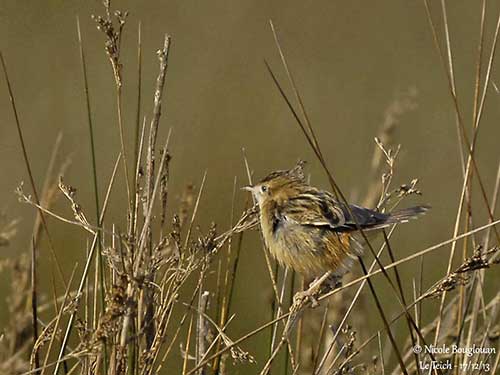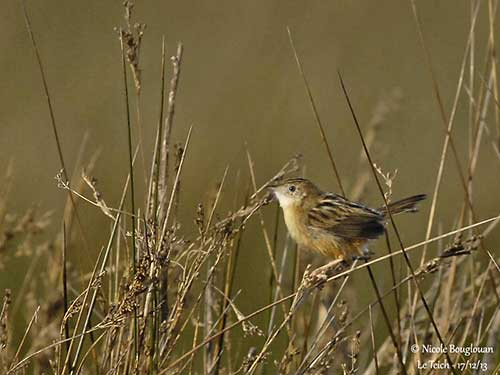
Fr: Cisticole des joncs
Ang: Zitting Cisticola
All: Zistensänger
Esp: Cistícola Buitrón
Ita: Beccamoschino comune
Nd: Graszanger
Sd: Grässångare
Photographers:
José Luis Beamonte
Pájaros de España
Nicole Bouglouan
PHOTOGRAPHIC RAMBLE
Text by Nicole Bouglouan
Sources:
HANDBOOK OF THE BIRDS OF THE WORLD Vol 11 by Josep del Hoyo, Andrew Elliott and David Christie - Lynx Edicions - ISBN: 849655306X
ENCYCLOPEDIE DES OISEAUX DE FRANCE ET D’EUROPE – de Peter Hayman et Rob Hume - Flammarion – ISBN : 2082009920
L’ENCYCLOPEDIE MONDIALE DES OISEAUX - Dr Christopher M. Perrins - BORDAS - ISBN: 2040185607
THE HANDBOOK OF BIRD IDENTIFICATION FOR EUROPE AND THE WESTERN PALEARCTIC by Mark Beaman, Steve Madge - C. Helm - ISBN: 0713639601
BirdLife International (BirdLife International)
Pájaros de España (JL Beamonte)
Wikipedia, the free encyclopaedia
Zitting Cisticola
Cisticola juncidis
Passeriformes Order – Cisticolidae Family
INTRODUCTION:
The Zitting Cisticola is an Old World Warbler whose wide range includes variations of populations with 18 recognized subspecies. It often occurs in grasslands and near water where it spends most time foraging among the vegetation, searching for insects and larvae.
The Zitting Cisticola is known for its aerial displays accompanied by regular “dziip” calls.
DESCRIPTION OF THE BIRD:
Biometrics:
Length: 10 cm
Weight: M: 7-12 g – F: 5-8 g
The adult has buffy or rufous-brown upperparts with dark streaks on crown, mantle, back and uppertail-coverts, and almost plain rump. The upperparts become duller and darker in worn plumage.
Flight feathers and tail are dark brown. We can see buff margins on flight-feathers and upperwing-coverts, whereas the tail is edged rufous-brown with blackish subterminal band and white tips (in fresh plumage).
The underparts are creamy-buff with paler throat and central belly. Flanks and vent are cinnamon-buff.

On the head, the male has plain buffy face. The creamy lores and eyering extend into the paler supercilium. Cheeks and neck-sides are washed rufous.
The bill is dark grey with pale lower mandible. The eyes are pale brown. Legs and feet are pinkish-flesh with long claws.
The non-breeding male has finer streaks on crown. The tail is slightly longer with narrower feathers. The bill is mostly pinkish-horn with dark culmen.
The breeding female has finer streaks on the upperparts and duller brown feather edges. The underparts are buffier. In non-breeding plumage, she is similar to the non-breeding male.
The juvenile resembles non-breeding adult, but it has more rufous upperparts with dull brown streaking, including on rump. Legs are paler pink and the eyes are duller.
SUBSPECIES AND RANGE:
The Zitting Cisticola has 18 recognized subspecies which differ mainly in plumage tone with paler or browner birds according to the range.
This species breeds in southern Europe, Africa (except deserts and rainforest) and S Asia, down to N Australia. The birds of the NE parts of the range are migratory and winter in regions of C and S India.

HABITAT:
The Zitting Cisticola frequents extensive dry or seasonally flooded grasslands, grassy wetlands, meadows, cereal crops, rice fields and pastures.
It forages mainly in marshy areas, in reedbeds and Salicornia saltmarsh. The nest-site is usually in fine grass, sedges or similar plant species. It often occurs in areas of tall grass, rushes and reeds.
This species is usually seen at low elevation, but according to the range, it may be found up to 1000 metres in Spain, 3000 metres in E Africa, 2400 metres in S Africa, 2100 metres in India and 1800 metres in SE Asia.
CALLS AND SONGS: SOUNDS BY XENO-CANTO
When flushed, the Zitting Cisticola’s common call is a single “chip” or “plip” note.
The song is a single, hard “tsip” or buzzier “tzeep” repeated at short intervals from perch or in flight.
The aerial display is a zigzagging flight accompanied by regular “zitting” calls, usually a single buzzing note uttered at top of each bounce during the undulating flight.
When disturbed, both male and female may perform wing-snapping.
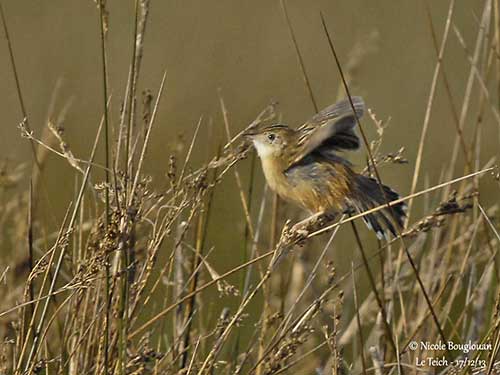
BEHAVIOUR IN THE WILD:
The Zitting Cisticola often perches on exposed grass or rush stems while moving casually its tail. It forages among grasses and gleans preys from bases of clumps of grasses. It occasionally hawks flying insects. It forages by walking and hopping on the ground.
Its diet includes insects and small invertebrates such as grasshoppers, mantids, dragonflies, moths, caterpillars and insect larvae, mayflies and flies, spiders and snails. Some grass seeds are taken too.

The Zitting Cisticola can be seen alone, in pairs or in small family groups, and the juveniles often form flocks of up to 100 birds.
During the breeding season, the Zitting Cisticola performs aerial displays. The male performs a zigzagging flight often high in the air, up to 35 metres and more. It flies over a territory of several hundred metres while singing. Sometimes, the male sings from a perch too.
Most males are polygamous. They start several nests in order to attract females. When a female accepts the male, she completes the nest.
The breeding season is related to the rains and usually, two broods per season are produced.
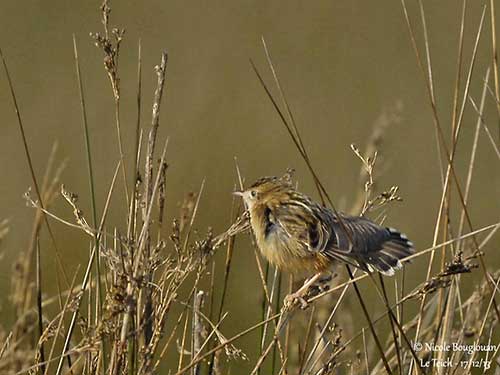
The Zitting Cisticola is largely resident in most parts of the range. However, it may move locally according to weather conditions and seasonal changes in the habitat.
The birds of the NE range are migratory. They breed in N India, Nepal, China, Korea and Japan, and winter in parts of C and S India.
The Zitting Cisticola performs an undulating song flight during the displays. It flies high in the air while zigzagging.
REPRODUCTION OF THIS SPECIES:
The breeding season occurs between March and September in Europe, but this period varies depending on the range. The male attracts a female by flying in pendulum flight over her, then, it leads her to the nest-site, and finally, it circles 1 metre above her while giving soft calls.
The male builds a vertical pear-shaped nest with an entrance at top. It uses live vertical grass leaves held together with vegetal down and spider web. This structure is placed between 10 and 50 centimetres in dense clump of grass. Once the nest is selected by the female, she lines it with plant down, fine grass, spider web and wool.
The male starts to build a new nest as soon as the female uses the existing one, or if this nest is not used after one week.
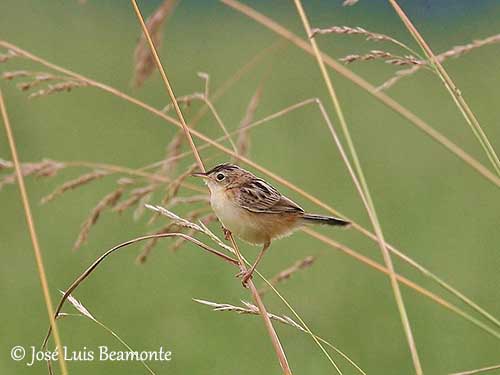
The female lays 4-6 eggs but the clutch varies according to the range. She incubates during 11-15 days, occasionally fed by the male but rarely. She feeds the chicks which fledge 11-15 days after hatching. They still depend on female for food for 10-20 days after fledging.
The nest is occasionally parasitized by the Common Cuckoo.
PROTECTION / THREATS / STATUS:
The Zitting Cisticola is common throughout most parts of the wide range. The population is increasing, following expansion of the range in recent years.
The global population is unknown, but the European breeding population is estimated at 230,000/1,100,000 breeding pairs, equating to 690,000/3,300,000 individuals.
The Zitting Cisticola is currently evaluated as Least Concern.
